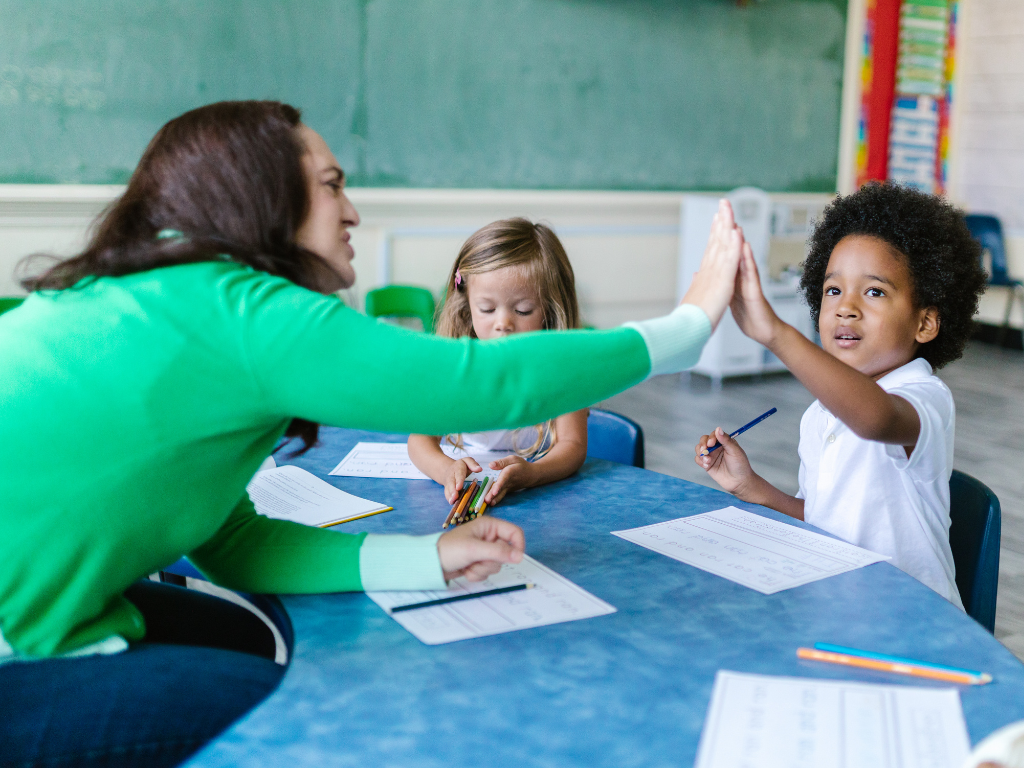5 Tips for Fostering a Positive Learning Environment for Students with Autism

April is World Autism Month, also known as Autism Acceptance Month (officially kicking off with World Autism Awareness Day on April 2), and we observe this month as a time to increase understanding and acceptance of the autism community. During this month, millions of people show their support by wearing blue, making donations to autism-related foundations, volunteering their time, and posting on their socials to raise awareness and encourage acceptance.
April is a wonderful month for the autism community. And that includes the millions of selfless individuals who work throughout each year to ensure children with autism spectrum disorder have the right environment—a positive learning environment—in which to learn, grow, and attain success.

What is a Positive Learning Environment?
A positive learning environment is one in which students feel comfortable and safe, both physically and emotionally, participating in class. A positive learning environment for students with autism is a must, as it can help them learn and retain information while being comfortable in an environment with limited distractions.
5 Tips for Creating a Positive Learning Environment for Students with Autism
Every child with autism has their own unique needs that must be addressed in the classroom. Below are five tips teachers can use to create a positive learning environment for students with autism.
1. Make Schedules and Stick to Them
Many people with autism thrive in an environment that is structured, organized, and detailed. Knowing what to expect during any given time throughout the day helps them feel comfortable and secure. When you create a schedule, students with autism know what’s coming and when, which helps them settle into the learning environment.
Given that people diagnosed with autism spectrum disorder are generally more successful in an organized and structured environment, it’s no surprise that children with autism prefer predictable routines to guide them through their school day. Creating routines—and not deviating from them—allows students with autism to take comfort in knowing what’s next and what will happen at that time.
2. Reduce Distractions
Children with autism can be very easily distracted, even by things we may not think are distractions. Within a classroom, these include windows, doors, wall decorations that don’t reinforce your teaching…they’re all potential distractions for students with autism. So is clutter, so be sure to keep teaching and learning materials neatly organized and preferably out of sight to avoid distraction or overstimulation. You need your students’ undivided attention, so create a classroom environment that allows for that, where students can look at you without obstruction or distraction.
3. Create a Comfortable Physical Space
While easing their minds goes a long way toward creating a positive learning environment for students with autism, so does a comfortable physical space. As we mentioned, even the most innocuous detail might cause distraction for a student with autism, so be sure to eliminate as much unnecessary environmental stimuli from the classroom. This includes:
- Keeping the classroom at a comfortable climate for everyone
- Avoiding wall signage and other visual materials
- Ensuring the lights are at the right brightness level and not flickering
- Not wearing perfumes, colognes, or scented lotions; the fragrance may distract students
- Having the class loudspeaker at a lower level
Some of these may be out of your hands, but if you speak to school leadership about the potential issues that could arise from a less-than-ideal physical classroom environment, they may be able to help solve some of these problems (dimmer switches for the lights, a programmable thermostat, an adjustment to speaker volume, etc.). Additionally, you may be able to make some exceptions for students with autism to help them become more comfortable in the classroom—allowing students to wear baseball caps in class to block out excess light, providing hand fidgets or other toys to help them focus, permitting them to wear noise-canceling headphones to address sound concerns, and providing different seating options (cushions, stools, yoga balls) to help with sensory input.
4. Make Sure There Are Dedicated Learning Spaces and Safe/Calming Spaces
Knowing that students with autism thrive in a structured environment, establishing dedicated spaces for both learning and calm time can be quite beneficial in the classroom. Set up learning stations throughout the room, such as a designated area for reading, a space for playing, and an area for doing desk or table work. Make sure you mark these clearly through color coding or minimal signage.
Similarly, every classroom serving children with autism should feature a space where they can go to calm down and de-stimulate. This space should include a comfortable chair or beanbag cushion, a few sets of noise-canceling headphones, some fidget toys, and any other calming tools you know work for your students.
5. Communicate Clearly (in a Variety of Ways)
Students with ASD communicate on a wide range of levels. Some students with autism may be very conversational, others may be entirely non-verbal. You will need to adjust your communication style, possibly from child to child, to effectively reach them and create a positive learning environment. Every student should feel comfortable asking a question or communicating, whether that’s through hand or body gestures or verbal communication. As an educator, you’ll likely need to adapt to each student’s communication style so you’re able to address their needs and teach them in the way they learn best.
How Teachers Can Deal with Sensory Overload in the Classroom
Students with autism are going to experience sensory overload or overstimulation at some point in your classroom. How will you know when that’s happening? Here are a few signs:
- Physical symptoms such as stomach aches, headaches, or an increased heart rate
- Anxiety that presents as fidgeting, distress, or restlessness
- Avoidance behavior such as closing eyes and covering ears
- Frustration and irritability, which can lead to conflict with teachers and/or classmates
What’s the best way to handle sensory overload?
- Adjusting lighting
- Having headphones, earbuds, or earplugs available
- Offering fidget toys such as spinners, putty, or stress balls
- Adding short sensory breaks into the day, which allow children to relax and refocus
Putting these measures into place within your classroom can help prevent sensory overload from happening in the first place, but it can also help diffuse the situation should it arise.
Strategies to Encourage Positive Social Interactions Between Students and Educators
Social interactions for students with autism are often quite daunting—not because they don’t want to engage with others, but because some children know that they don’t have the same socializing skills as other students, which prompts them to avoid interacting altogether. This is where teachers enter the picture. There are strategies to employ that can help students with autism improve their social skills.
- Pair the struggling student with a peer who has strong communication and social skills. This may help the student with autism feel more comfortable interacting.
- Use behavior-specific praise and positive reinforcement to emphasize what the child does well socially.
- Demonstrate social interaction.
- Infuse social learning into activities that the student is successful at.
- Make context clues a part of your instruction.
- Identify the student’s social strengths and personality traits and use those as starting points for social interactions.
- Break students into small activity or lunch groups and use structured activities or conversation starters to have them socialize about a certain topic.
- Practice social skills individually with the child before introducing them to a peer setting.
- Teach empathy by helping students with autism with their vocabulary and their recognition of others’ feelings, non-verbal signals, and facial expressions.
How SESI Can Help
Autism presents differently in every child, which is why we believe that there’s no “one-size-fits-all” approach to education. We offer different classroom approaches, each individualized to meet every student’s needs and prepare them for life beyond school.
SESI’s 95-plus standalone schools and more than 100 In-District Classroom partnerships help students with autism by meeting their academic, behavioral, social, and emotional needs through expert support, personalized instruction, and evidence-based learning models.


